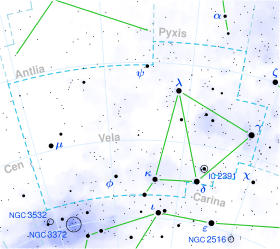HD 88955
| Observation data Epoch J2000 Equinox J2000 | |
|---|---|
| Constellation | Vela[1] |
| Right ascension | 10h 14m 44.1557s[2] |
| Declination | −42° 07′ 18.989″[2] |
| Apparent magnitude (V) | 3.85[3] |
| Characteristics | |
| Evolutionary stage | main sequence[4] |
| Spectral type | A2 V[3] |
| B−V color index | +0.051±0.005[1] |
| Astrometry | |
| Radial velocity (Rv) | +7.4±2.7[5] km/s |
| Proper motion (μ) | RA: −149.929[2] mas/yr Dec.: +49.548[2] mas/yr |
| Parallax (π) | 31.6369±0.1684 mas[2] |
| Distance | 103.1 ± 0.5 ly (31.6 ± 0.2 pc) |
| Absolute magnitude (MV) | 1.39[1] |
| Details | |
| Mass | 2.17[6] M☉ |
| Radius | 2.11[6] R☉ |
| Luminosity | 23.24[6] L☉ |
| Surface gravity (log g) | 4.08±0.14[7] cgs |
| Temperature | 9,451±321[7] K |
| Metallicity [Fe/H] | −0.02[8] dex |
| Rotational velocity (v sin i) | 100±4[9] km/s |
| Age | 410[6] Myr |
| Other designations | |
| q Velorum, CD−41°5713, FK5 382, GC 14076, HD 88955, HIP 50191, HR 4023, SAO 221895[10] | |
| Database references | |
| SIMBAD | data |
HD 88955 is a single,[11] white-hued star in the southern constellation of Vela. It can be viewed with the naked eye, having an apparent visual magnitude of 3.85.[3] The distance to HD 88955 can be determined from its annual parallax shift of 31.6 mas,[2] which yields a distance of 103 light years from the Sun. It is moving further from the Earth with a heliocentric radial velocity of +7 km/s.[5] Bayesian analysis suggests HD 88955 is a member of the Argus Association,[12] a group of co-moving stars usually associated with the IC 2391 open cluster.
This is an A-type main-sequence star with a stellar classification of A2 V.[3] It is about 410 million years old[6] with a projected rotational velocity of 100 km/s.[9] The star has 2.17 times the mass of the Sun[6] and 2.11 times the Sun's radius.[6] It is radiating 23 times the Sun's luminosity[6] from its photosphere at an effective temperature of 9,451 K.[7] An infrared excess has been detected from HD 88955, which analysis suggests is a (3.6±3.0)×10−7 M🜨 debris disc with a mean temperature of 138±21 K orbiting the host star at an average distance of 19.3±5.7 AU.[13]
References
[edit]- ^ a b c Anderson, E.; Francis, Ch. (2012). "XHIP: An extended hipparcos compilation". Astronomy Letters. 38 (5): 331. arXiv:1108.4971. Bibcode:2012AstL...38..331A. doi:10.1134/S1063773712050015. XHIP record for this object at VizieR.
- ^ a b c d e f Vallenari, A.; et al. (Gaia collaboration) (2023). "Gaia Data Release 3. Summary of the content and survey properties". Astronomy and Astrophysics. 674: A1. arXiv:2208.00211. Bibcode:2023A&A...674A...1G. doi:10.1051/0004-6361/202243940. S2CID 244398875. Gaia DR3 record for this source at VizieR.
- ^ a b c d Malagnini, M. L.; Morossi, C. (November 1990), "Accurate absolute luminosities, effective temperatures, radii, masses and surface gravities for a selected sample of field stars", Astronomy and Astrophysics Supplement Series, 85 (3): 1015–1019, Bibcode:1990A&AS...85.1015M.
- ^ Lagrange, A.-M.; Desort, M.; Galland, F.; Udry, S.; Mayor, M. (2009). "Extrasolar planets and brown dwarfs around A-F type stars. VI. High precision RV survey of early type dwarfs with HARPS". Astronomy and Astrophysics. 495 (1): 335. arXiv:0809.4636. Bibcode:2009A&A...495..335L. doi:10.1051/0004-6361:200810105.
- ^ a b de Bruijne, J. H. J.; Eilers, A.-C. (October 2012), "Radial velocities for the HIPPARCOS-Gaia Hundred-Thousand-Proper-Motion project", Astronomy & Astrophysics, 546: 14, arXiv:1208.3048, Bibcode:2012A&A...546A..61D, doi:10.1051/0004-6361/201219219, S2CID 59451347, A61.
- ^ a b c d e f g h Gáspár, András; et al. (August 2016), "The Correlation between Metallicity and Debris Disk Mass", The Astrophysical Journal, 826 (2): 14, arXiv:1604.07403, Bibcode:2016ApJ...826..171G, doi:10.3847/0004-637X/826/2/171, S2CID 119241004, 171.
- ^ a b c David, Trevor J.; Hillenbrand, Lynne A. (2015), "The Ages of Early-Type Stars: Strömgren Photometric Methods Calibrated, Validated, Tested, and Applied to Hosts and Prospective Hosts of Directly Imaged Exoplanets", The Astrophysical Journal, 804 (2): 146, arXiv:1501.03154, Bibcode:2015ApJ...804..146D, doi:10.1088/0004-637X/804/2/146, S2CID 33401607.
- ^ Saffe, C.; et al. (October 2008), "Spectroscopic metallicities of Vega-like stars", Astronomy and Astrophysics, 490 (1): 297–305, arXiv:0805.3936, Bibcode:2008A&A...490..297S, doi:10.1051/0004-6361:200810260, S2CID 15059920.
- ^ a b Hales, Antonio S.; et al. (April 2017), "Atomic gas in debris discs", Monthly Notices of the Royal Astronomical Society, 466 (3): 3582–3593, arXiv:1612.05465, Bibcode:2017MNRAS.466.3582H, doi:10.1093/mnras/stw3274, S2CID 119223132.
- ^ "HD 85622". SIMBAD. Centre de données astronomiques de Strasbourg. Retrieved 2018-08-08.
- ^ Eggleton, P. P.; Tokovinin, A. A. (2008), "A catalogue of multiplicity among bright stellar systems", Monthly Notices of the Royal Astronomical Society, 389 (2): 869, arXiv:0806.2878, Bibcode:2008MNRAS.389..869E, doi:10.1111/j.1365-2966.2008.13596.x, S2CID 14878976.
- ^ Malo, Lison; et al. (January 2013), "Bayesian Analysis to Identify New Star Candidates in Nearby Young Stellar Kinematic Groups", The Astrophysical Journal, 762 (2): 50, arXiv:1209.2077, Bibcode:2013ApJ...762...88M, doi:10.1088/0004-637X/762/2/88, S2CID 118497872, 88.
- ^ Thureau, N. D.; et al. (2014), "An unbiased study of debris discs around A-type stars with Herschel", Monthly Notices of the Royal Astronomical Society, 445 (3): 2558, Bibcode:2014MNRAS.445.2558T, doi:10.1093/mnras/stu1864, hdl:10023/6011.

